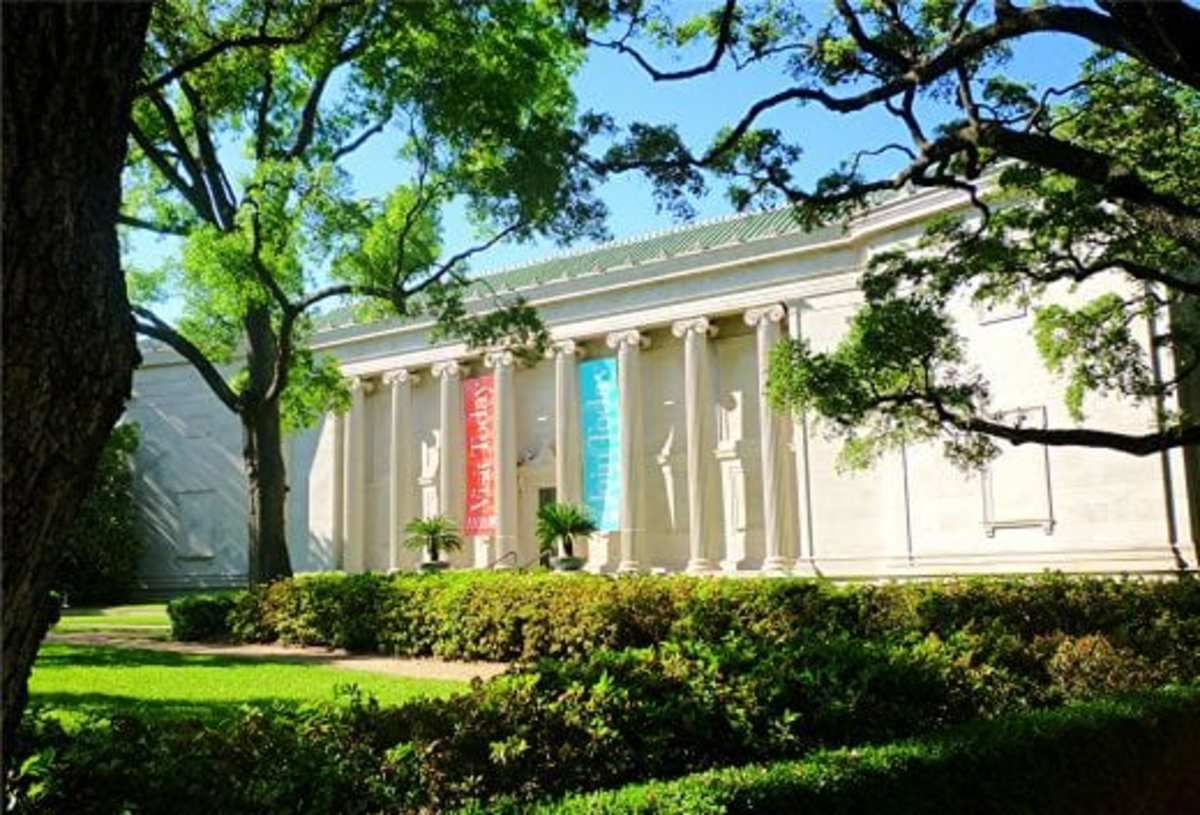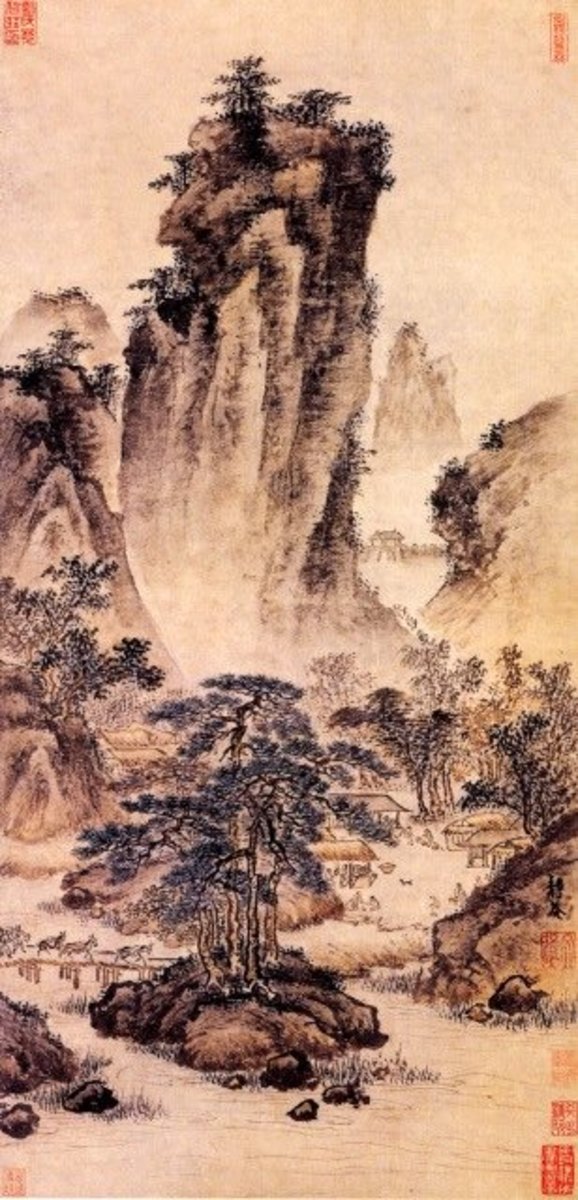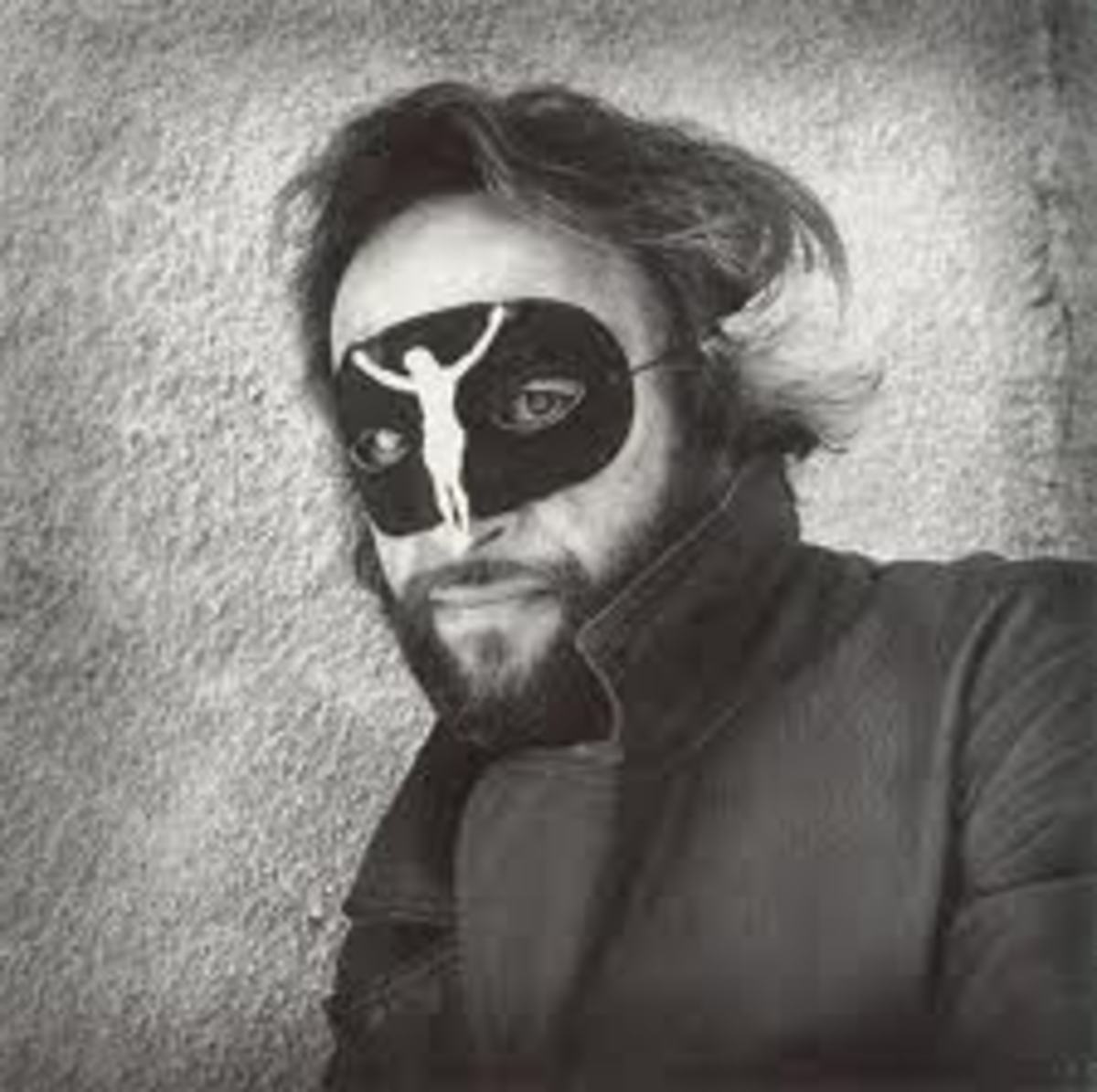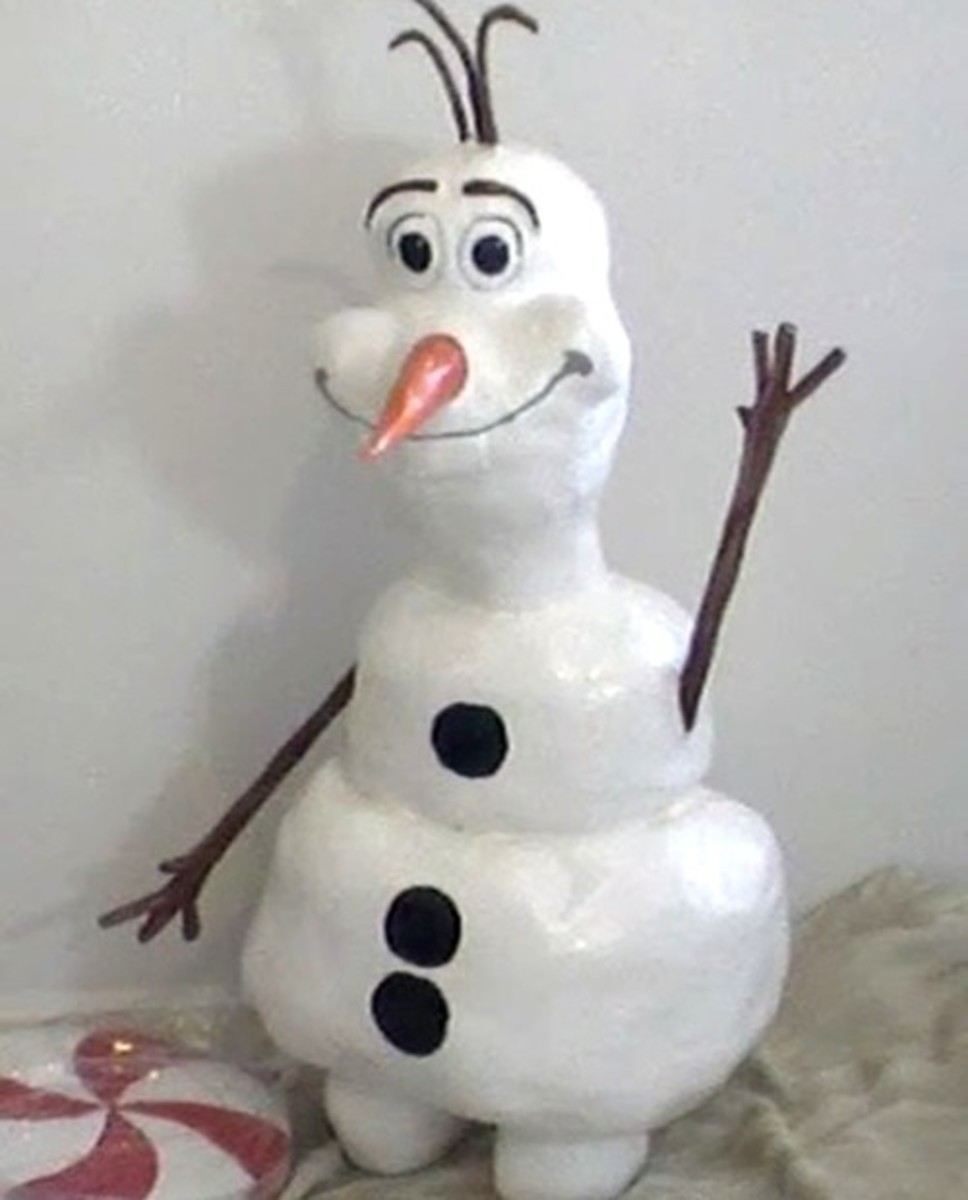How I personally define art
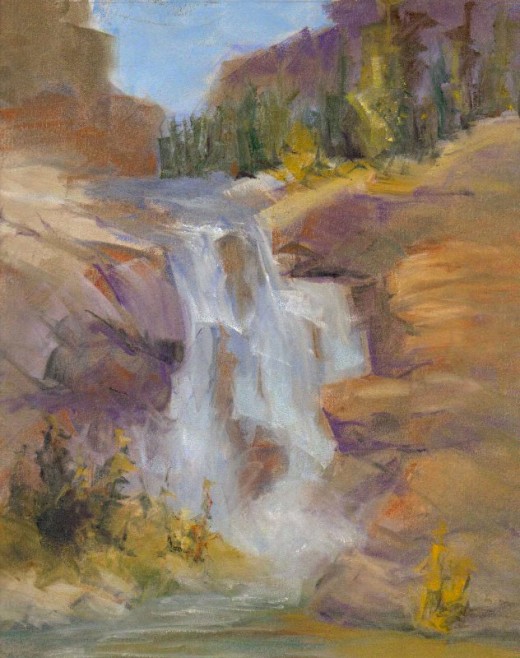
Why Define Art?
Coming up with definitions of art is a good pursuit to get attention at a certain type of party. Especially if you're in college, work for a college or hang around with people who've been to college it's one of those subjects you can bring up instead of Religion or Politics to have something to talk about.
Of course the discussion revolves around a modern concept that Fine Art is a high status profession that should be admired by people of wealth and taste, while mere Illustration or Design or Crafts are just the irrelevant folk art of uneducated people amusing themselves with inferior materials. But it gets better. What is Art? also brings in another level of class distinction. The one where you've had enough Art History classes in college to know that a porcelain toilet signed by a Famous Artist is Art, but that lovely painting of a waterfall by your friend isn't Art because he's just a leisure painter, a hobbyist.
Famous Artists of centuries past were craftsmen. They got paid quite a lot of money to carve stone decorations for cathedrals, build cathedrals and paint Bible illustrations on the walls and ceilings of cathedrals because the churches had a lot of money to afford their expert services. Sometimes wealthy aristocracy could afford to have portraits done of themselves or their loved ones. Even if they were famous in their times, it wasn't exactly on the order of a famous soldier or an aristocrat - they were artisans doing something expected to be difficult, take years of training and require an apprenticeship.
In my view, the idea of Fine Art is a social construct tied in with ideas of class and status. Every generation seems to hold its own traditions as rebelling against everything that came before. Originality was the keyword of the 20th century, yet mysteriously it was applied to anyone using the styles and techniques of a few famous masters. To this day if you paint something that would have shocked people in 1950, it may get called Original even if you're working directly within the ideas and techniques of the original rebels.
Fine Art gets that line of definition because art pricing is subjective. Paintings, drawings, sculptures and even illustrations are worth what people will pay for them.
Does that mean the term is meaningless except in marketing? Does that mean all galleries are frauds, selling trash to wealthy people along with a happy line of intellectual blather that they can display to show off their erudition? Not necessarily.

Is the River Girl cover Art?
To the side you'll see another of my drawings. I used an archival, lightfast sepia colored pencil on 100% rag Stonehenge paper to create a monochrome drawing based on a scene in the novel River Girl by Linda Jo Martin. Experts would call this commercial art.
To me, commercial art is art.
I drew a scene from the book. I worked from photo references of the setting of the book, studying the landscape and thinking of the story. I read the entire book before designing it so that I'd be able to convey the feel of the story. A young girl moves to the very small town of Happy Camp in the Pacific Northwest, where she struggles with loneliness and physical hardship yet finds beauty in the river and the land. No spoilers here, but this is a good book. I was inspired by the character and setting. I did a good job on the cover, bucking a modern trend to create covers by collaging digital photos on the computer.
Norman Rockwell counts as a fine artist.
Frank Frazetta, whose paintings are equally brilliant and powerful, doesn't get mentioned as a fine artist. Charles R. Knight, whose nature paintings are seen in many prominent museums, hovers somewhere between them in reputation. I'm a relative unknown who did a book cover for an online friend at a reasonable price competing with the photo-collage artists yet drawing it by hand because I knew how - and produced a lot of fine art before doing this cover.
Compare the River Girl cover to my other landscapes and it's still a good landscape that happens to have a figure in it rather than a landscape without a figure. Is this drawing Not Fine Art because it was inspired by a novel? What if I'd just bought the novel, been inspired to draw it and sold it as a landscape inspired by River Girl?
Granted, I would have done something else with the composition and probably cropped it, since I planned the drawing to include the text. But just because it was drawn for a commercial purpose does not mean that it isn't art. It's a drawing. It's art used to illustrate a novel cover rather than art used to illustrate a different story painted on the walls of a church.
I say that it's art. My basis for saying that is that I'm the artist. I intended my River Girl cover to stand as fine art as well as serve the purpose of tempting readers to buy a good novel that I enjoyed. My best credential as an artist is that I can draw and paint well.
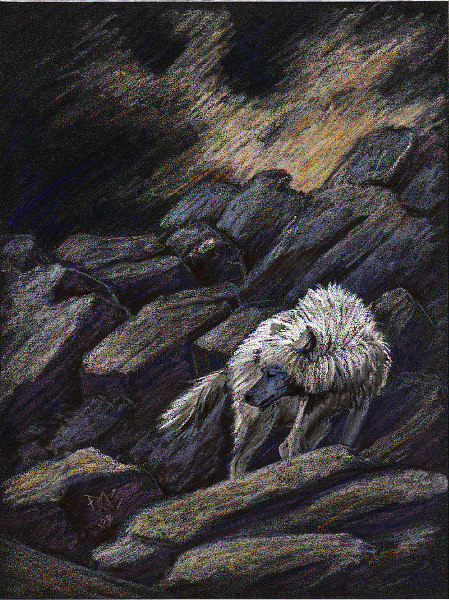
Art Definitions and Art Pricing
The pastel drawing above is literally priceless. I didn't sell it. I gave it to my son in law and created it for him for Christmas 2009 because I know he loves wolves. Inspired by my love for my son in law, I hunted down good references and created a dark moody landscape with a white wolf picking his way down the rocks.
Like the cover illustration for River Girl, this drawing tells a story. Unlike that drawing, this story has no beginning or end, no text, it's a glimpse into the life of a beautiful animal. The story exists in your imagination and of course, my son in law's imagination. Some people will read this animal as menacing. Others will see the white wolf by moonlight as romantic. Everything I ever thought or felt about wolves went into it.
At the time I drew it, I was charging much less for my artworks than they're worth by market value. That's not uncommon for artists to do. When you're close to a painting or drawing, remember every stroke that went into it, there's too much temptation to be humble and not think of your own works as memorable or powerful. Even when you recognize one of them came out well, the thought of translating that into money can still bring hesitation.
In only two years since I drew this, I've improved. My landscapes have better design, principles that I applied unconsciously are now understood and I plan better when I'm doing something major. This one came out better than many of the pieces I did in 2009. Yet if it wasn't done out of love, its price would be going up now because my skills improved and I raised my prices.
One of the little-known counter-intuitive things about art pricing is that if a good artist prices the work too low, buyers don't think it's worth as much. Price it too high and they'll look at the next artist and say "I can get something just as good for half the price, you egotist." So pricing your own art is a matter of trial and error for everyone that sells art, whether that's a leisure painter treating it as a self-sustaining hobby or a serious professional.
One of the reasons I often priced low was that I was pricing to my own income - and I live on a small fixed income. I didn't stop to think that a department store manager, a banker, a veterinarian might fall in love with one of my drawings and need to own it. Or that for people on my income, smaller, simpler works and good high quality prints are an option.
So there's this going on for the artist. Marketing and selling art is a completely different set of skills than actually creating good artwork. There are brilliant fine artists out there in the world who are completely unrecognized because they are leisure painters. They may have spent 20 or 30 or 40 years learning to paint well and achieved works that belong in museums without ever thinking of selling any of them. Their friends and relatives are incredibly lucky to receive those paintings as gifts. If they're kept well, at some time in the future an art historian may discover these unknown masters.
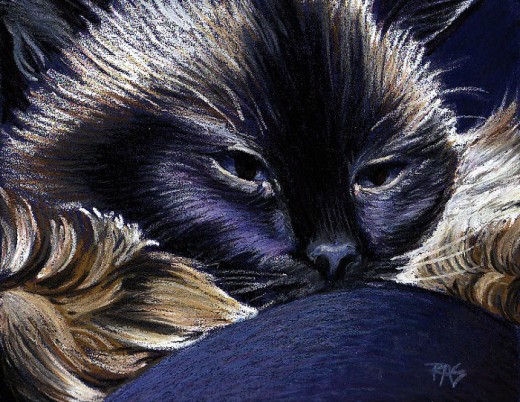
What Art Means
Above is another priceless painting I've done. This one I did for myself, it's a portrait of my faithful color point longhair cat, Ari. I snapped a photo reference while he was half-dozing purring on my leg, you can't see it but just outside the image my hand was gently scritching his neck to keep him happy and sitting still. I used archival artist grade oil pastels and an archival artist grade sanded pastel card, this painting is going to last much longer than my living companion or me unless it gets destroyed in a fire or something.
It represents something deeply personal, a relationship nearly 12 years long with a personal Muse that I've sketched hundreds of times. It took me dozens of tries to create a portrait of this cat to my own satisfaction and I may improve on it this year since I've been studying intensively. I can see technical flaws in it that I didn't understand at the time - fortunately they're minor and not in the focal area. His face is perfect. I captured his expression and personality in a sweet, sleepy, loving mood.
I've got a big collection of Ari paintings by artist friends. Some are professionals commanding much higher prices than I do for their art. I share this cat's photos freely in several art communities and posted his photos as challenges. I've painted and drawn him so often that my friends tease me and call me the Cat Master - but I know animal painters whom I admire and look up to as far better than I am.
That's natural. No matter how good any artist gets, he or she can't encompass everything that all artists have learned in the history of art or keep from inventing something new. Artists learn constantly. That's half the joy of it - the masters are always also students and often take workshops with each other to keep honing their skills.
So what does this mean?
This one is still mine because that goes to the heart of why people buy art and hang it on their walls. It means something to them. It's personal. They fall in love just the way you fall in love with a living person or a distant celebrity. Something deep in human instinct draws us to good design, accurate rendering, meaningful symbolism.
We have an instinct to paint and draw that runs as deep in us as it does in bower birds. It's not all tied in with mating the way it is with the bower birds. Some artists may paint well in order to impress potential lovers but the better they get at it, the more likely they go on painting by getting engaged with the art itself.
We can visit the caves in Lascaux, France and many other locations to see priceless, ancient art created 30,000 years ago by people who didn't speak our language, people who had their own cultural and personal reasons to fill the walls of a cave with oil paintings of horses and rhinos, bears and lions, stylized people with spears. Some of them are hunt scenes. Others are just the animals. Others are mysterious chevrons and linear patterns that still somehow strike home as something human and real.
Those artists may not have been doing it for money. In a sense they did because their tribes supported them while they worked on the grand projects. They may have been shamans. They may have been painters trading art for healing from shamans. We don't know and can't know why any of them chose the subjects they did or rendered them the way they did.
We understand them nonetheless and they go right to the heart.
When someone buys art, they're bringing something real into their homes that is personal. It could be a cheap poster or an original painting, it could be a limited edition print or a small statue. It could be anything.
When I was in a homeless shelter, other homeless people were hanging images clipped from magazines and various cards they got from relatives on the walls near their beds. Most of them had some personal images decorating their area even if that was no more than a small patch of wall above a narrow bed.
Mass production means that even the poorest of the poor can find and claim and keep brilliant art. Take a long look at the paintings on greeting cards. Behind every one of them is a working professional artist, many of them fine artists who happened to sell an image that fit a theme the card company was using. They're not big reproductions or high quality ones, they'll yellow and fade, but they are fine art. Just as often, you'll see cards with reproductions of old masters on them that are unequivocally fine art.
It's all art. It's all something that individual human beings value as an image and find some inspiration from. Art speaks to people. Art touches something deep in the self and moves people to reflect on themselves, their society, the themes the artists guided them to.
If some of them are "just photos," think again. Photography is an art. The level of skill needed to capture a sunny woodland landscape for a greeting card is phenomenal and the photographer needed to take hundreds, maybe thousands of spoiled shots before cropping it and tweaking it in the computer to get it perfect to say what he or she wanted to say about the scene, create the mood. I learned a lot about composition by studying photography articles.
The camera is a tool, just the way a pencil or a brush or a pigment stick is. We have more variety in materials including better, more archival materials than artists have ever had before in the history of art. Ancient techniques like encaustic and fresco painting get revived while new materials like Oil Pastels or Pan Pastels are invented so often that the artist is left reeling for choice. We'll use whatever tools are available and create new ones if we need them and get an idea for how to get that effect.
Some of these instinctive reactions are cross-cultural. Others are culturally determined. Asian painting treats perspective and space very different, nothing like the way Western painting does. Yet today most artists are online and exposed constantly to Asian art history, incorporating that into our views. The conciseness of Asian art is breathtaking. The poetry of strokes becomes immediately moving because Asian calligraphy is done with a brush, painters are poets in a way Western painters weren't always also calligraphers.
It's not enough to just get the facts of the image right. Yes, that's my cat. I got his markings right, his eye color, his fur texture. What made this mean so much more to me is that I captured the feel of him on my leg and the deep love that shines through even in the painting. I love him. I would not trade this for the most beautiful cat painting by the greatest painter on the planet, because I love this subject so personally - he's my Ari and that was an intimate moment. It's very personal.
So why is it that so many people say art "isn't real work?" What happened to the artisans and craftsmen, back in the centuries when painting Bible scenes in churches was a good trade that brought people up into the middle class along with the cathedral builders?
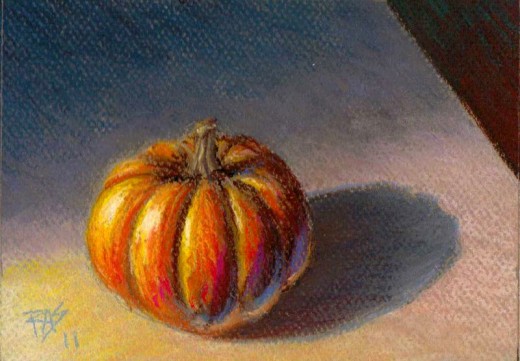
Why Art Matters
The question of "What is Art?" has as many answers as there are people who think the question is important. They range from my blue collar grandfather's "I don't know anything about Art but I know what I like" to art historians who can follow and research the history of various techniques, themes, schools and ideas throughout world history, to experts who define art in ways that help some people feel superior for appreciating art that's hard to understand. From outside, art that isn't accessible at a glance to the general public seems elitist and often ugly or frightening. Sometimes that was the intent of the artist and a visceral rejection of the piece is just what the artist meant to create.
Like food or wine, tastes in art can be refined. Learning more about art appreciation can help you discover why the artworks that move you have such a powerful effect - why one person's rendering of a common vegetable comes out looking trite and another makes you feel like singing. Ultimately though, beyond that art appreciation education, personal taste always comes into it and often the group tastes of particular groups.
My white wolf drawing has a different meaning to anyone who enjoys the White Wolf roleplaying games about vampires and werewolves. It might take on a particular story meaning. Someone could go "That's my character in his wolf form!" and that story about a werewolf adds a new personal layer of meaning to something I drew to celebrate nature. That meaning is as valid as mine. Art is always personal. Art pricing is subjective because the value of art is subjective.
Good design and principles of composition, color, technique can improve art. Because it exists to communicate, that's like having good pacing, good vocabulary, poetic skill in writing. It's not something so specific that I think it can be codified in "This is Art" and "This Isn't Art" except by people who hold a specific theory. Some people may never appreciate how brilliant Frank Frazetta's landscapes are because giant snakes and brawny barbarians occupy the focal point. Very often we still fall into the ideas of the Academy where it's Art if it's the right subjects and Not Art if it's not.
Terry Pratchett plays off this beautifully in his novels when he describes paintings like "Three Large Pink Women with One Piece of Gauze." Think about it. You've seen that in a museum or an art history book. It's Art because there's urns in it, or those little toddlers with wings. It's Not Art if it's just naked women without urns. But do you really need the urns to tell that it's art?
The best answer to "What is Art" is yours. I've shared mine and used five of my own artworks to illustrate it so that I'm not stepping on anyone's copyrights to their photos of famous artworks. One was done as commercial art, the others are paintings I've sold, given away or kept for myself. Before I became disabled I worked full time as an artist in New Orleans selling life portraits in the French Quarter. I had paintings in several galleries in the city and was continually experimenting with different techniques and methods. Now I live in San Francisco and I'm doing the same thing at a slower pace, mostly at home because of those disabilities.
To me, if I've drawn or painted or sculpted it, then it's art. If I love the image, then it's art. I appreciate the unsung artists as much as the famous ones. The nature photo in an insurance ad may strike me deep with inspiration, then I want to paint something to answer it. A cartoon on a cereal package may make me smile and think about giving a figure in a painting that gesture. I'll look close at graphic novels, see panels as individual artworks and look at the page as a whole for composition. The more I learn about art, the more beautiful others' artworks are to me even if their style and method are nothing like mine.
Art matters because it is that personal. It becomes that individual. It carries that much meaning and identity. Art tells you who you are and art lets you share that with the people who are part of who you are, because being human we are social beings. Art is what's there when life gets dull or painful, to pull us out of ourselves and think of ways to improve things or just get through a bad night better. Art can open cathartic floodgates and heal the mind or it can stab at the heart of social injustice. Some of the most powerful artworks in history don't even count as art - but they are. They moved people and became icons or symbols. Think of the American flag. That's an art work hand and machine copied for centuries and it's so powerful as a symbol that it's displayed in countless artworks. Yet it's just a pattern in three colors with a set symbolism decided back at the founding of the USA.
It's art. Art carries meaning and that meaning becomes specific when you bring in everything else you've read or seen or heard in your life. Because it's fluid and personal, it may not mean the same thing to everyone that sees it but good art will have a powerful impact even if you don't like it. An ugly painting by a master painter will revolt you far more than just a lousy painting by a beginner.
Art is where people connect with culture and identity, beyond that with our instincts and sense of self. Art may be created for a purpose but when it's good it's often repurposed - how many times have the church illustrations from the Sistine Chapel been used to make this or that point including atheists' arguments? To me it's all Art and whether it's good or whether you like it, both of those things you have to answer for yourself.


